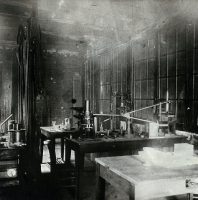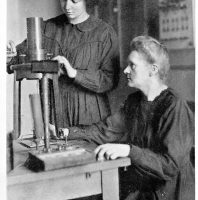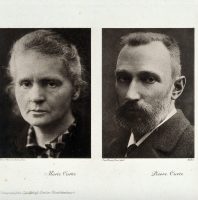When and where was she born?
Marie Skłodowska Curie was born on 7 November 1867, in Warsaw, Poland. She died in Passy in France on the 4th July 1934.
Fun facts
- Marie never lost her Polish identity and named the first chemical element she discovered, polonium after her native country.
- She worked with her husband and had two children;
- She gave away the prize money from her two Nobel prize awards and also did not copyright her work, to ensure everyone could benefit from it;
- Marie Curie is one of the most revered scientists of her time, and still inspires scientists to this day. In 2009 she was voted in the New Scientist Magazine as ‘the most inspirational woman in science’;
- The Marie Curie charity provides care and support to people with a terminal illness that can’t be cured, such as cancer.
What’s important about her scientific work?
Inspired by the discovery of radioactivity by Henri Becquerel in 1896, alongside her husband, Pierre Curie, Marie discovered radium and polonium and developed important theories on radioactivity. She developed the first treatments for cancer, and also developed portable x-ray machines.
What do we know about her childhood?
Marie’s family lost all their property and fortunes so her family was poor but her father made sure she was well educated. She won a gold medal whilst at school, and kept it in her drawer, like treasure to remind her what she could achieve. As a girl, she wasn’t allowed to attend university with her brother, and moved to Paris, France.

What struggles did she face?
- When she went to university, she had to study in a new language, French, despite this she soon became the best maths and science student in Paris;
- Marie had to earn a living teaching as well as working on her discoveries.
- In June 1903, Marie and her husband Pierre Curie were invited to the Royal Institution in London to talk about radioactivity, however Marie was not allowed to speak as she was a woman so Pierre had to give the speech;
- There was not the same understanding about the need for safety in the laboratory, and as a result, she was often sick and eventually died as a result of her exposure to radiation.
What did she achieve?
- 1903 alongside husband Pierre Curie, and Henri Becquerel, Marie Curie won the Nobel Prize in Physics and in1911 she won a Nobel Prize for Chemistry. She was the first woman to win a Nobel Prize, and the first person to win two Nobel Prizes in different sciences.
- She founded the Curie Institutes in Paris and Warsaw which remain major centres of medical research today;
- In 1921 she was offered a Legion of Honour award for her work in World War 1 but she refused to accept it;
- She was the first woman to teach at the Sorbonne University in Paris.















